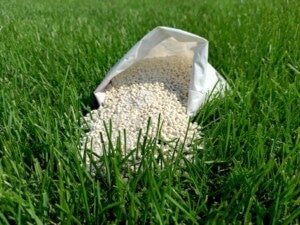Grass Seed, Fertilizer and Garden Lime
Keep your lawn lush and healthy long-term with a little routine maintenance.
Over time, well-established lawns may begin to show signs of wear, tear, and stress, so it’s important to implement a regular maintenance routine of overseeding and fertilizing to support your lawn’s long-term health.
The average blade of grass lives for about 40 days, meaning your lawn is constantly expending energy to produce new grass. Over time, grasses can become worn out and may not produce enough new blades to replace the older grass that is dying off, resulting in thinner coverage. To compensate, we recommend that property owners overseed their existing turf once a year to create a consistently thick, healthy lawn. With the cool season grasses typically used in Canada, it’s best to overseed early in Spring or in Fall.
Choosing the Right Grass Seed Blend or Grass Cultivar
Much like garden plants, different grasses have evolved to perform best in their unique environments. Some grasses will prefer heavy sunlight while other varieties can tolerate shade wth aplomb. Some grasses require regular watering while others are drought tolerant. The trick to picking the perfect grass seed is to choose one that will perform well in your property’s unique environmental conditions.
Over the years, we’ve put our knowledge to use and developed a series of grass blends to ensure high-performance quality throughout the Lower Mainland’s unique regional climates.
Grass Seed Blends for Residential Lawns & Commercial Properties
Select Seed – Our Select Seed blends Kentucky Bluegrass with Perennial Ryegrass to create a top performer that does well in the milder West Coast climate.
Supreme Seed – This versatile seed blend of Kentucky Bluegrass and Perennial Ryegrass is a great choice for durability and beauty, and can be used in all growing areas with excellent results.
Enviro Organic Seed – A unique blend that combines Kentucky Bluegrass and Fescue to create a lawn that is drought tolerant with low water needs – perfect for a variety of Western Canadian climates, from Vancouver Island to Calgary.
Bentgrass Seed – A premium creeping grass that’s perfect for creating a luxurious showcase lawn, this grass can be used throughout the Lower Mainland and surrounding areas.
More details and specifications for sod for Residential Lawns and Commercial Properties
Grass Seed Blends for Sports Fields
Sports Turf West Coast Blend – High Perennial Ryegrass blended with Fescue
Sports Turf Interior Blend – High Kentucky Bluegrass Blend with Perennial Ryegrass and Fescue
More details and specifications for sod for Sports Fields
Grass Seed Blends and Cultivars for Golf Courses
Penn A4 Creeping Bentgrass
Penncross Creeping Bentgrass
007 Creeping Bentgrass
T-1 Creeping Bentgrass
Pure Distinction Creeping Bentgrass
Perennial Ryegrass
Kentucky Bluegrass
More details and specifications for sod for Golf Courses
Custom blends are available upon request – call the office to speak with our staff about your specific needs today! 1-888-888-7072
Are you using fertilizer for your lawn?
If not, you are not getting the best results possible. Most people think of sunlight and water when they consider their lawn’s needs, but just as important is the soil, and the soil has needs of its own.
Why You Need Fertilizer?
While the soil will provide some nutrients to your lawn, it is not enough to meet all your lawn’s needs. Adding fertilizer helps your lawn to stay healthy by providing the nutrients and energy it requires. Specifically, the key elements that will give you rich soil that support a thriving lawn are phosphorous, nitrogen, and potassium. Without even one of these, your lawn will suffer, appearing brown and shrivelled.
With several types of fertilizer available, how do you know which one is right for your needs?
Fertilizers By the Numbers
Fertilizers use a rating system comprised of three numbers. The first number is nitrogen, followed by phosphorous, and finally potassium, with the chemical notations for these elements being N, P, and K. The numbers themselves represent the percentages of these ingredients in the bag.
A fertilizer labelled 21-7-14 has the highest concentration of nitrogen, at 21%. The phosphorous concentration is 7% and the potassium is 14%. The ratios you want can vary depending on your needs. A new lawn will have different needs than one which is established.
-
Nitrogen (N)
The first number, nitrogen, is helpful for above-ground growth and provides a lush, green lawn. nitrogen deficiency results in a yellow-green colour and slow growth.
-
Phosphorous (P)
Phosphorous establishes growth below ground, with healthy root systems. This helps create a strong foundation. A phosphorous deficiency results in slow or stunted growth.
-
Potassium (K)
This important mineral helps with overall health and building strong cells in the plant tissue, allowing it to endure various stressors, such as heat, cold, pests, and disease. A deficiency in potassium can cause weak stems and slow growth.
Knowing the concentrations of these elements helps you decide which fertilizer you need. In spring, providing a balanced product helps with root growth, building strong cells, and above-ground growth, making 18-18-18 fertilizer a good choice. Summer lawn care, however, benefits from a mix of 24-4-8, which keeps your lawn green, but has less phosphorous because there is little root growth at this time. Fall is the time for potassium, with a blend of 15-5-30, which helps prepare the grass and roots for the coming winter.
Benefits of Fertilizer
Your lawn uses up the nutrients in the soil, which need to be replenished to keep it healthy. Fertilizer will help your grass grow faster and greener. It is simple to use, and it is a cost-effective way of growing and keeping a beautiful lawn. The right fertilizer can also help your lawn recover from insect damage and resist heat, drought, and wear damage. It can also help improve grass density, aiding with weed control.
Why Should I Fertilize?
When it comes to diet, plants are similar to people in that they need a balanced diet of nutrients in order to grow and thrive in their environment. Established lawns in particular benefit from a regular fertilizer regimen that supports a lawn’s unique dietary needs throughout the seasons, replenishing depleted resources in the soil.
As the seasons change, the lawn’s dietary needs do too. In the fall, lawns benefit from an application of quick-release nitrogen to store up for winter survival. In spring, fertilizers use a slow-release nitrogen to sustain long-term growth throughout the growing season. For more detailed information on seasonal fertilizing and product selection, check out our blog.
If you are considering ordering seed or sod from us, ask about adding Green Booster 21.0.0 and All Season Builder 18.18.18 to your order so you can feed your lawn like the pros!
About Garden Lime
Turf grasses perform best when the soil they grow in has a neutral pH, meaning it is neither acidic or basic. Particularly during seasonal changes, soils tend to be a little acidic and may benefit from a light application of lime. Dolomite lime, also known as garden lime, is a mild base that is commonly used in the lawn care industry to correct acidic soils. As an added benefit, dolomite lime is a form of calcium – an important nutrient in plant diets!
Not sure if you should apply lime to your lawn? Check out this helpful resource, talk to your lawn care professional, or give us a call at 1-888-888-7072 to see if your lawn might benefit from garden lime!


